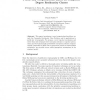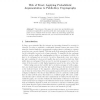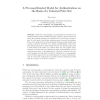EUROCRYPT
2006
Springer
14 years 11 months ago
2006
Springer
To prove that a secure key-agreement protocol exists one must at least show P = NP. Moreover any proof that the sequential composition of two non-adaptively secure pseudorandom fun...
PKC
1998
Springer
14 years 11 months ago
1998
Springer
The concept of public-key cryptography was invented in 1976 by Diffie and Hellman [DH]. The following year, Rivest, Shamir and Adleman provided an implementation of this idea [RSA]...
109
click to vote
EUROCRYPT
1999
Springer
14 years 11 months ago
1999
Springer
Abstract. This paper investigates a novel computational problem, namely the Composite Residuosity Class Problem, and its applications to public-key cryptography. We propose a new t...
CCS
2001
ACM
14 years 12 months ago
2001
ACM
The Domain Name System (DNS) is a distributed database that allows convenient storing and retrieving of resource records. DNS has been extended to provide security services (DNSSE...
DSN
2002
IEEE
15 years 12 days ago
2002
IEEE
This paper describes a Secure INtrusion-Tolerant Replication Architecture1 (SINTRA) for coordination in asynchronous networks subject to Byzantine faults. SINTRA supplies a number...
ECSQARU
2003
Springer
15 years 20 days ago
2003
Springer
1 The purpose of this paper is to show how probabilistic argumentation is applicable to modern public-key cryptography as an appropriate tool to evaluate webs of trust. This is an ...
BPM
2003
Springer
15 years 20 days ago
2003
Springer
Abstract. Public-key cryptography is a prerequisite for security in distributed systems and for reliable electronic commerce. The protection of public keys against attacks is the A...
EWSN
2008
Springer
15 years 7 months ago
2008
Springer
Abstract. By using Elliptic Curve Cryptography (ECC), it has been recently shown that Public-Key Cryptography (PKC) is indeed feasible on resource-constrained nodes. This feasibili...
PERCOM
2005
ACM
15 years 7 months ago
2005
ACM
In this paper, we quantify the energy cost of authentication and key exchange based on public-key cryptography on an 8-bit microcontroller platform. We present a comparison of two...
PERCOM
2007
ACM
15 years 7 months ago
2007
ACM








